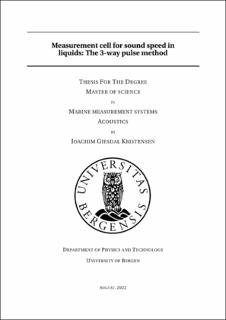| dc.description.abstract | In the oil and gas industry, high precision sound velocity measurements are vital to estimate the water cut of extracted oils. The water content is of great importance as it plays a crucial part in determining parameters such as production rates and custody transfer. While models such as the UNESCO-algorithm can be used to calculate the sound velocity in water, such models are not always available for oils, as they depend on the exact composition of hydrocarbons. Since water cut is found from accurate sound velocity measurements of the different phases in an emulsion, devices capable of measuring sound velocity with high precision are essential. In this thesis, a high-precision measurement cell for sound velocity measurements in liquids, with a relative expanded uncertainty limit of 1000 ppm at 95% confidence level, is developed and tested. The measurement cell is based on the 3-way pulse method. Some preferences were set in advance by XSENS Flow Solutions, and have been implemented into the design of the measurement cell. Sound velocity measurements have been performed on distilled water, saline water at 20, 35 and 50 ppt salinity, respectively, and Exxsol D120 oil. Two signal processing methods; the zerocrossing method (ZCM) and the Fourier spectrum method (FSM) have been utilized, and two different diffraction correction methods have been applied to the measurements. The experimental sound velocities have been compared to modelled sound velocities throughout the project. The best agreement between the experimental and modelled sound velocities was within 628 ppm in distilled water and 744 ppm in saline water. Only the experimental sound velocities found with the ZCM that are corrected for diffraction using Method 2 are within 1000 ppm of the modelled sound velocity across all sound velocity measurements in this work. A number of different uncertainty contributors have been identified throughout the project. They are treated in different uncertainty models, and an example uncertainty budget has been carried out for the experimental sound velocity in distilled water at 25◦C. The relative expanded uncertainty at 95% confidence level was found to be 422 ppm. Diffraction correction was found to be the main uncertainty contributor. | |
